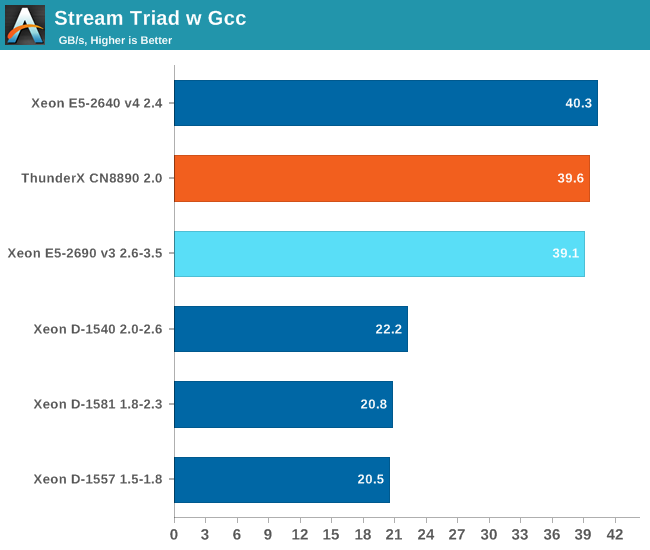Investigating Cavium's ThunderX: The First ARM Server SoC With Ambition
by Johan De Gelas on June 15, 2016 8:00 AM EST- Posted in
- SoCs
- IT Computing
- Enterprise
- Enterprise CPUs
- Microserver
- Cavium
Memory Subsystem: Bandwidth
Bandwidth is of course measured with John McCalpin's Stream bandwidth benchmark. We compiled the stream 5.10 source code with gcc 5.2 64 bit. The following compiler switches were used on gcc:
-Ofast -fopenmp -static -DSTREAM_ARRAY_SIZE=120000000
The latter option makes sure that stream tests with array size which are not cacheable by the Xeon's huge L3-caches nowadays.

The ThunderX keeps up with the midrange Xeon E5s. The relatively low numbers might surprise a lot of people, as Stream benchmarks now hit 100 GB/s and beyond easily these days. First of all, these are of course single socket measurements, as opposed to the typical dual socket stream tests. Secondly, only the "high-end" and "segment optimized" Intel SKUs support DDR-2400, many SKUs are "limited" to DDR4-2133. With DDR4-2400, Xeon E5's score would increase to 48 GB/s per socket.
Last but not least: we do not use the icc compiler. Using the icc compiler boosts the performance of this benchmark by 33% (to 64 GB/s). That raw bandwidth is most likely only useful in some AVX-optimized HPC applications, a market that the ThunderX does not target. So far, so good: the ThunderX memory controller delivers twice as much bandwidth as Intel's Xeon D SoC. It is the first time the Xeon D gets beaten by an ARM v8 SoC...










82 Comments
View All Comments
Daniel Egger - Wednesday, June 15, 2016 - link
I could hardly disagree more about the remote management of SuperMicro vs. HP. Remote management of HP is *the horror*, I've never seen worse and I've seen a lot. It's clunky, it requires a license to be useful (others do to but SuperMicro does not have such nonsense), the BCM tends to crash a lot (which is very annoying for a remote management solution), boot is even slower than all other systems I know due to the way they integrate the BIOS and remote management on the system and it also uses Java unless you have Windows machines around to use the .NET version.For the remote management alone I would chose SuperMicro over most other vendors any day.
JohanAnandtech - Thursday, June 16, 2016 - link
I found the .Net client of HP much less sluggish, and I have seen no crashing at all. I guess there is no optimal remote management client, but I really like the "boot into firmware" option that Intel implemented.rahvin - Thursday, June 16, 2016 - link
Not only that but Supermicro actually releases updates for their BCM's. I had the same shocked reaction to the HP claim. Started to wonder if I was the only one that thought supermicro was light years ahead in usability.I should note that Supermicro's awful Java tool works on Linux as well as windows. Though it refuses to run if your Java isn't the newest version available.
pencea - Wednesday, June 15, 2016 - link
All these articles and yet still no review for the GTX 1080, while other major sites have already posted their reviews of both 1070 & 1080. Guru3D already has 2 custom 1080 and a custom 1070 review up.Ryan Smith - Wednesday, June 15, 2016 - link
It'll be done when it's done.pencea - Wednesday, June 15, 2016 - link
Unacceptably late for something that should've been posted weeks ago.Meteor2 - Thursday, June 16, 2016 - link
Will anyone read it though? Your ad impressions are going to suffer.Ryan Smith - Thursday, June 16, 2016 - link
Maybe. Maybe not. But it's my own fault regardless. All I can do is get it done as soon as I reasonably can, and hope it's something you guys find useful.name99 - Thursday, June 16, 2016 - link
Give it a freaking rest. No-one is impressed by your constant whining about this.pencea - Thursday, June 16, 2016 - link
Not looking to impress anyone. As a long time viewer of this site, I'm simply disappointed that a reputational site like this is constantly late for GPU reviews.